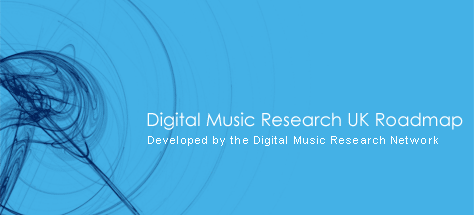- Machine
Listening
- Fertile environments for creativity
- Music Exploitation and Distribution
- Musical Innovation
- High-Level Parametric Control
- Sound Reproduction and Recording
- Fertile environments for creativity
- Music Exploitation and Distribution
- Musical Innovation
- High-Level Parametric Control
- Sound Reproduction and Recording
Research Goals in Digital Music: A Ten Year View
 Musical Innovation
Musical Innovation
Music created using computer technology has become a key expression of 21st century
culture. Many people now have access to creative digital music tools through the
widespread dissemination of computing and portable computing technology, the internet
and software applications which enable musical creation (including software produced
by the academic community over the past 30-40 years which is now in the public
domain). These developments have resulted in a burgeoning contemporary music scene
and new approaches to musical materials and musical composition. Over the next ten years engineering research in the field of digital music should embrace evolving musical forms and new opportunities for musical performance and dissemination (including sound art installation and new forms of music distribution informed by developments in rights management, such as Creative Commons). This will ensure relevance to new aesthetics and cultural developments that have taken place in recent years - enabling researchers to seek solutions to contemporary musical problems and applications.
Many digital music research questions, which were hindered in the past by poor computational performance for audio applications, poor digital audio storage and non-real-time interactive audio applications, have now been solved. Current technologies can provide good digital audio storage capabilities and good performance for audio computation.
New research questions are now emerging related to sophisticated human/computer interfaces, techniques and strategies for the control of information about music and creative musical processes. Contemporary techniques to extract complex descriptive information from audio signals will lead to new approaches to the organisation of musical materials and their control within processes of musical creation and production.
The public performance of digital musics will also provide significant opportunities for research. Contemporary developments in human computer interaction, machine listening and mechanisms to integrate technology with human performers will be fertile ground for research. The integration and application of existing technologies in the context of human musical performance and intelligent musical interaction will be challenging problems. There are also significant opportunities to investigate new approaches to the control of computer music, algorithmic composition and the application of computer algorithms for live performance and improvisation.
New approaches to musical performance will require developments in music reproduction systems, such as surround sound. This field seems likely to evolve to include the use of spatial encoding strategies which require very large numbers of audio channels and large numbers of loudspeakers for use in a variety of contexts (including the cinema and concert hall). Technological developments and research in loudspeaker systems, spatial sound encoding strategies and the human perception of sound will inform developments in this area.
Music performed with computers, or generated by them, has been shown to provide little opportunity for audiences to understand or engage with live performance or improvisation. Technical developments in these areas will benefit from close links to aesthetic and artistic research. New methods of presentation, presentation contexts and presentation sites (e.g. internet, public spaces or personal audio systems) could be enabled by further technological research and development.
Research in human/computer interface (HCI) technologies for music is an established field which finds application in music and other areas of HCI research. Research into computer mediated communication is also an emerging field. Developments in these areas will continue, related to advances in the electronic hardware capable of sensing human actions and to the mapping of sense-data to digital music processes.
It is appropriate for technological innovation to be applied in many musical genres. New technologies and musical innovations are not the preserve of 20th Century Avant Garde or experimental genres. New forms of digital and post-digital music (whose operating cultures are outside academia), contemporary jazz, pop, rock, fusion, ethnic musics and many other genres are fertile ground for research into the application of new digital music technologies. Engaging with new and emerging forms of music will allow technology researchers to contribute to a living and developing musical culture.
Communication and collaboration between artists and engineers can produce valuable research outcomes. A greater integration of disciplines and less rigid definitions of subject areas is required to move from the notions of multi-disciplinary work towards the concept of research that is inherently transdisciplinary. Problems can occur in communication between artistic, creative and scientific collaborators which has, to date, resulted in a slow acceptance of some technical innovations by musical communities. It will be important to establish dialogues and understanding between creative and technical innovators in music. Research and education in this area will be important to sustain research in the future.
Research in human perception of sound, and other human science disciplines, has a potential to impact significantly on creative digital music research and related engineering research. Digital music research should incorporate researchers working in these fields. Notably, sound has been shown to be significant in the development of key models of cognitive operation and to have provided insight in research into brain function (Kohler et al 2002). Important information related to physiology, cognition and brain science may result from transdisciplinary research activity in this area, in addition to human science data that will inform music technology innovations.
New methods of sound creation, generation and control have been at the heart of developments in digital music for the past fifty years. New aesthetics based entirely upon synthetic or artificial sound materials and their control, are now significant international creative cultures. New musics and new methods of sound generation will remain key areas of research and development.
Research is required to enable creators to exploit musical data in the complex, multi-parametric control medium presented by computer technology. Research is required in areas ranging from sound file management and the application of automatic music classification systems, to processes which allow the integration of information to inform, say, signal processing or creative processes. [see High Level Parametric Control]
Technology will continue to facilitate new approaches to the composition of music. Fields such as algorithmic composition and performer interaction with compositional rules will be fruitful areas of research.
Developments are also expected in the area of live computer algorithms for performance. These computer systems, which will interact strongly with musicians in both a supportive and a creative capacity, will be a fusion of ideas from algorithmic music, live electronics, cognitive science, artificial intelligence and performance activities. The challenge is to endow live algorithms with properties typical of human performance: strong interactivity, autonomy, innovation, idiosyncrasy and comprehensibility.
New forms of musical notation, its representation and the display of information about sound will create new tools for musical analysis and interaction with sound materials during the creation of music. Techniques for user interaction with notations, scores and visual displays will provide benefits to composers, performers, sound engineers, producers, musicologists and musical analysts.
It will be extremely important to research new engineering developments, technologies and methods within a professional and contemporary musical context. New technologies for composition and audio processing should integrate musical expertise at a professional level. A challenge for digital music research will be to engage with professional musical creators in a variety of innovative musical genres. It is important to ground research in this field through a focus on relevant problems. This will integrate knowledge accumulated by musicians about the nature, approach and methods of music, its creation, dissemination, performance and interpretation.
Creative outcomes can be developed to illustrate many engineering research developments in this field. This has many potential benefits and should be encouraged: it can illustrate research contexts, contribute to future engineering research developments, public awareness, dissemination and the industrial take-up of research.
Digital music research should attempt to reach out to wider musical communities where musical innovation is welcomed. Research in digital music should actively support the UK community of innovative professional music creators and performers.
Enabling musical innovation is a key goal in digital music research. The creation of new musics from new technologies will allow digital musical research to make a significant contribution to 21st century creative culture and creative industries in the UK.
Reference
Kohler E., Keysers C., UmiltÓ M.A., Fogassi L., Gallese V., Rizzolatti G. Hearing sounds, understanding actions: action representation in mirror neurons. Science, 297: 846-848, 2002.
[Top]

